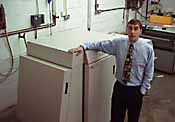
The Kodak LED Digital Printer 20P
REAL PHOTOGRAPHIC PRINTS FROM DIGITAL IMAGES & BEAUTIFUL DIGITAL PRINTS FROM TRANSPARENCIES
By John Henshall
'The whole wedding album is made up of matching photographic prints - apart from that one dye sublimation print which sticks out like a sore thumb.'
'It was the bride's mother's fault. If she hadn't been so busy interfering with how everyone else looked, she wouldn't have been caught with that stupid goldfish expression. Pity there was no other shot of that group. Cloning her from the other group was the only way.'
'The stylist is really good with Adobe Photoshop now. It was worth every penny it cost to send her on the digital restoration and retouching course. If only the print didn't look so different from all the others, nobody's attention would be drawn to that picture.'
'These digital prints look fine on their own but, viewed alongside 'real' photographic prints well, they just don't look the same at all.'
'Having the retouched image file written out to a photographic negative seemed like a good idea but, oh, so expensive and our printer couldn't get the dress and flesh tones to print anywhere near those on the other prints. And the whole print looks out of focus. How I wish we'd taken just one more shot - the dramas it would have saved. Pity the poor groom with a mother-in-law who complains like that. That marriage won't last long - nor will our business if she goes on shouting her mouth off like that.'
'If only there was some way of getting true photographic prints from digital image files. If only'
You know, there are some good things about digital imaging, even for social photographers. In the digital world, if you can dream it you can do it - one day. And the good news is that that particular dream has just come true. At last, you can have 'real' chemically-processed photographic prints direct from digital image files which have never even heard of a darkroom. We have the technology.
Some of the digital printers use cathode ray tubes - small, very sharp versions of those inside out televisions - on which images are displayed, to be focussed on regular photographic paper. They work well enough, though the maximum size of print is very limited and flare and focus drift can be problematic. If you want huge prints, there are laser-driven printers which will print fifty two inches wide by up to a whole paper roll in length. These work very well, though there are resolution problems as the laser approaches the corners of large prints at an oblique angle, landing as an elliptical beam. And the ubiquitous inverse square law needs to be compensated for as the light travels further from the source to everywhere except the centre of the print. But these problems are not as major as the real estate requirement: these printers are big.

The Kodak LED Digital Printer 20P
So Kodak has
recently introduced a new kind of digital 'real' photographic
(including the wet bits) printer which makes prints up to 20x32
inches from digital image files: the attractively titled 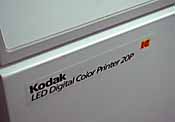 'Kodak
LED Digital Printer 20P'. Of course, all the individual elements of
this printer's name have particular individual meanings. 'Kodak'
indicates that it comes from, well, not Konica. 'Digital' means it
is, erm, digital - at least the part where the image goes in. And
'Printer' means it produces, would you believe prints - though it
gives us no clue to the fact that, deep in its bowels, these are good
old wet ones. The '20p' is, of course, the price - divided by 400,000
to avoid having too many noughts on the end. 'LED' obviously relates
to the printer's weight. Well I certainly wouldn't want to pick it
up, would you? It also occurs to me that some elements of this name
could have double entendres: for example 'LED' also means 'Light
Emitting Diode' and '20p' means that the machine takes '20 inch
[wide] paper'.
'Kodak
LED Digital Printer 20P'. Of course, all the individual elements of
this printer's name have particular individual meanings. 'Kodak'
indicates that it comes from, well, not Konica. 'Digital' means it
is, erm, digital - at least the part where the image goes in. And
'Printer' means it produces, would you believe prints - though it
gives us no clue to the fact that, deep in its bowels, these are good
old wet ones. The '20p' is, of course, the price - divided by 400,000
to avoid having too many noughts on the end. 'LED' obviously relates
to the printer's weight. Well I certainly wouldn't want to pick it
up, would you? It also occurs to me that some elements of this name
could have double entendres: for example 'LED' also means 'Light
Emitting Diode' and '20p' means that the machine takes '20 inch
[wide] paper'.
In fact, the LEDs are the really novel part of
this printer. They spin around on a head pivoted at the 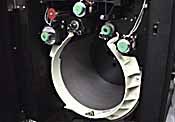 centre
of a drum inside which the RA4 paper is held very accurately just the
merest smidgen of a gnat's whisker away from the glowing LEDs.
Because the LEDs are pivoted at the centre of the drum, they are
always at right angles to the paper. A lead-screw drives the LED-head
across the width of the paper, scanning it with varying amounts of
coloured light to expose the emulsion. This system avoids unevenness
of exposure, which has to be compensated for in laser devices, and
definition drop-off towards the edges. Clever stuff, eh?
centre
of a drum inside which the RA4 paper is held very accurately just the
merest smidgen of a gnat's whisker away from the glowing LEDs.
Because the LEDs are pivoted at the centre of the drum, they are
always at right angles to the paper. A lead-screw drives the LED-head
across the width of the paper, scanning it with varying amounts of
coloured light to expose the emulsion. This system avoids unevenness
of exposure, which has to be compensated for in laser devices, and
definition drop-off towards the edges. Clever stuff, eh?
After all this unnatural exposure to things digital, the RA4 paper takes a welcome dip in its familiar bath of salts before emerging with a stunning image at least as good - if not better - than a conventional photographic print.
I took a trip to Dunn's Professional Imaging in Birmingham - as much as anything to stop the boyish Alan Dunn pestering me with eMails eulogising his new toy. I'd been threatening to pay Dunn's a visit for some years, so it seemed a good excuse. I took with me some real hard customers which I hoped would quieten him down.
One was a 6x6cm Fuji Velvia transparency with enough dynamic range to silence the three tenors. Another was a very soft lit Fuji 64T tranny of Kinnock and Thatcher (remember them?) against a white background for a 'Spitting Image' commercial. My DCS420 shot of the guard at Horse Guard's Parade, which started off its life as a 1.5MB camera file, was a bit of a joker. What would that be like at 16x20, I wondered? Finally, a 16MB monochrome file of Brian Whitehead, mastered on the Dicomed BigShot. A black and white picture to be output on a colour printer. What a test! I could hardly contain myself.
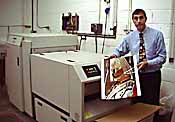 As
the prints - up to 20 inches wide by 32 inches long - rolled out of
the printer onto Dunn's slightly retro-looking print catcher, I
became speechless. The truth is, I was really annoyed by the prints.
I mean, I had done everything I could to break Dunn's new toy and,
sadly, I had to admit that I had failed. To make matters worse, Alan
Dunn seemed really to be enjoying seeing me squirm. He even called in
some reserve gloating from Andy Hughes.
As
the prints - up to 20 inches wide by 32 inches long - rolled out of
the printer onto Dunn's slightly retro-looking print catcher, I
became speechless. The truth is, I was really annoyed by the prints.
I mean, I had done everything I could to break Dunn's new toy and,
sadly, I had to admit that I had failed. To make matters worse, Alan
Dunn seemed really to be enjoying seeing me squirm. He even called in
some reserve gloating from Andy Hughes.
Back at the EPIcentre, I sent Dunn's the images from the Agfa ePhoto1280 in last month's Chip Shop, and a panorama of Sydney, by ISDN. The finished prints were delivered to me the next day.
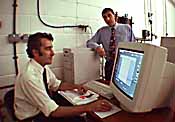 I
became Public Enemy Number One of the lab world a few years back for
daring to be kind enough to tell them they'd be out of business if
they didn't Go Digital. Dunn's had already Gone Digital in a big way.
They were the first to buy a Photo-CD Workstation and now they're the
first to buy a LED 20P. Another annoying thing is that they are
unnecessarily clever at everything - I think they actually work at
it. They have already closed down their reversal darkroom but instead
of firing their printer, Gordon Allen, they've retrained him to
operate a Macintosh (well that takes all of five minutes) and to
drive the new printer. Clever, eh? Carry his craft skills forward
into the digital age instead of consigning them to the scrap
heap.
I
became Public Enemy Number One of the lab world a few years back for
daring to be kind enough to tell them they'd be out of business if
they didn't Go Digital. Dunn's had already Gone Digital in a big way.
They were the first to buy a Photo-CD Workstation and now they're the
first to buy a LED 20P. Another annoying thing is that they are
unnecessarily clever at everything - I think they actually work at
it. They have already closed down their reversal darkroom but instead
of firing their printer, Gordon Allen, they've retrained him to
operate a Macintosh (well that takes all of five minutes) and to
drive the new printer. Clever, eh? Carry his craft skills forward
into the digital age instead of consigning them to the scrap
heap.
But how on earth do they do reversal prints, from transparency originals, without a darkroom? They become devious, that's how, scanning all their 'R' type orders onto Photo-CD before printing them on the LED 20P. I hate to admit it but the results are superb. Well they already know how to get the best out of Photo-CD scans, so they have an unfair advantage.
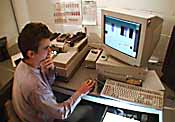 Speaking
of unfair advantages, I've just realised how you can take advantage
of Dunn's. If you send a transparency to them for ordinary reversal
printing they will scan it then print it on the new fangled 20P
printer at no extra charge. But they won't advertise the fact that
they are doing it this way. We've reproduced below part of one of the
prints they did for me, alongside a direct reversal print from the
same transparency. Note the much better tonal range of the digital
scan and print, with very pleasing handling of shadows and
highlights. Compare this with the high contrast and lack of tonal
separation in the highlights and shadows of the direct reversal
print. The only thing the LED 20P will not do is prints over twenty
inches wide. But the bread and butter is likely to be of prints up to
20x32 inches and there are other machines made especially for the
largest sizes.
Speaking
of unfair advantages, I've just realised how you can take advantage
of Dunn's. If you send a transparency to them for ordinary reversal
printing they will scan it then print it on the new fangled 20P
printer at no extra charge. But they won't advertise the fact that
they are doing it this way. We've reproduced below part of one of the
prints they did for me, alongside a direct reversal print from the
same transparency. Note the much better tonal range of the digital
scan and print, with very pleasing handling of shadows and
highlights. Compare this with the high contrast and lack of tonal
separation in the highlights and shadows of the direct reversal
print. The only thing the LED 20P will not do is prints over twenty
inches wide. But the bread and butter is likely to be of prints up to
20x32 inches and there are other machines made especially for the
largest sizes.
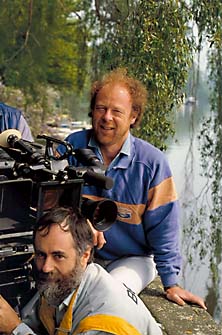
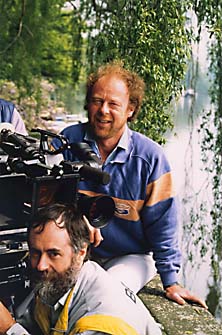
Left: LED print from the Kodak 20P Digital Printer and Right: A direct reversal print from the same transparency.
So you can kiss goodbye to digital prints sticking out from the rest like a sore thumb. And who's going to be first to bond one of these digital prints to canvas? Don't worry, I'll not be racing you to it.